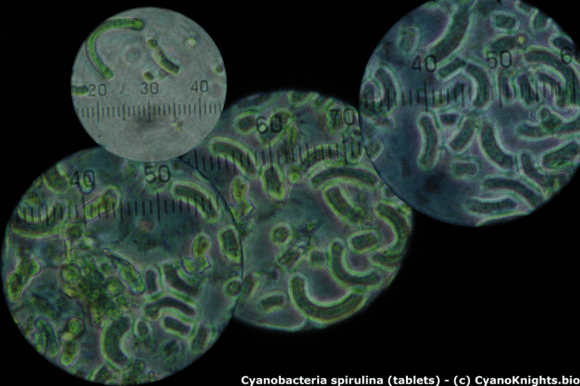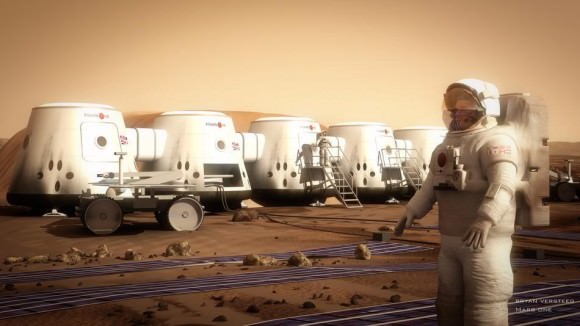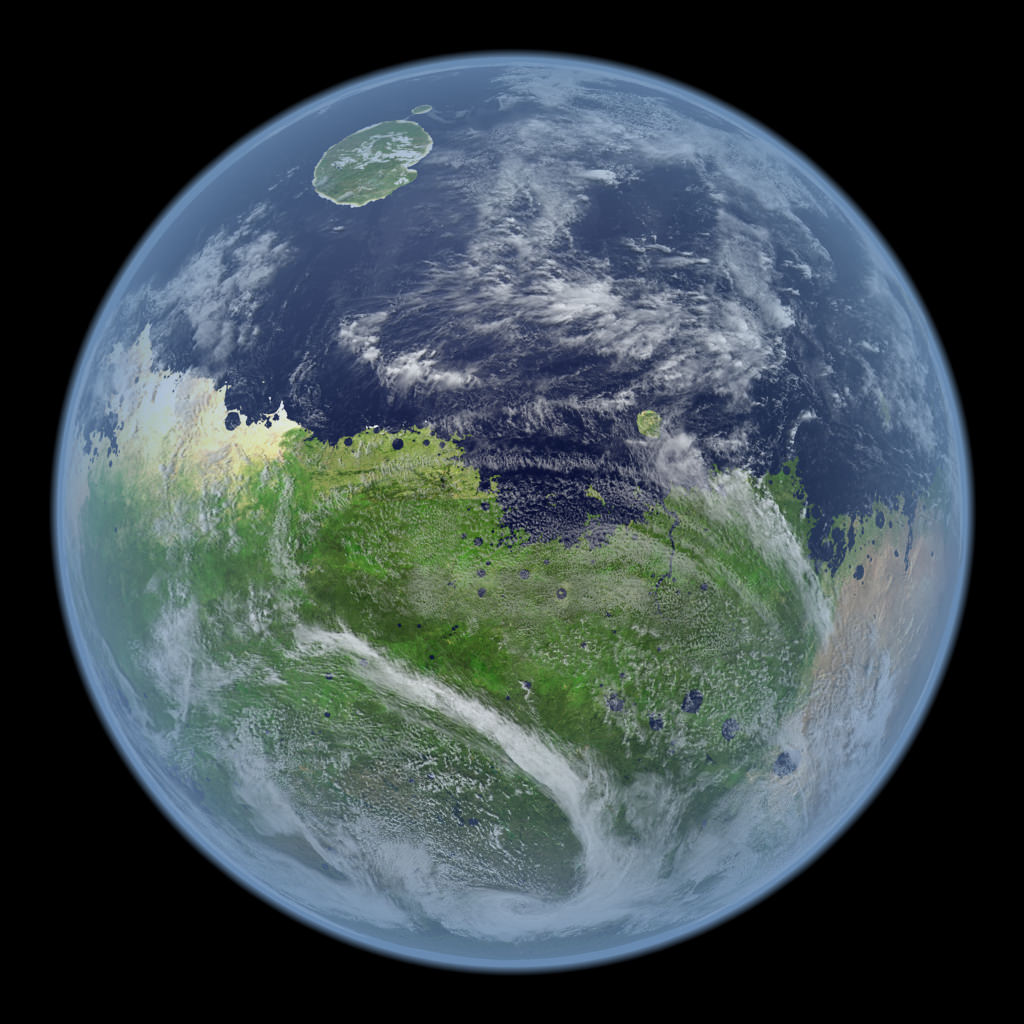While scientists believe that at one time, billions of years ago, Mars had an atmosphere similar to Earth’s and was covered with flowing water, the reality today is quite different. In fact, the surface of Mars is so hostile that a vacation in Antarctica would seem pleasant by comparison.
In addition to the extreme cold, there is little atmosphere to speak of and virtually no oxygen. However, a team of students from Germany wants to change that. Their plan is to introduce cyanobacteria into the atmosphere which would convert the ample supplies of CO² into oxygen gas, thus paving the way for possible settlement someday.
The team, which is composed of students and volunteer scientists from the University of Applied Science and the Technical University in Darmstadt, Germany, call their project “Cyano Knights”. Basically, they plan to seed Mars’ atmosphere with cyanobacteria so it can convert Mars’ most abundant gas (CO2, which accounts for 96% of the Martian atmosphere) into something breathable by humans.

Along with teams from other universities and technical colleges taking part in the Mars One University Competition, the Cyano Knights hope that their project will be the one sent to the Red Planet in advance of the company’s proposed settlers.
This competition officially began this past summer, as part of the Mars One’s drive to enlist the support and participation of universities from all around the world. All those participating will have a chance to send their project aboard the company’s first unmanned lander, which will be sent to Mars in 2018.
Working out of the laboratory of Cell Culture Technology of the University of Applied Science, the Cyano Knights selected cyanobacteria because of its extreme ruggedness. Here on Earth, the bacteria lives in conditions that are hostile to other life forms, hence why they seemed like the perfect candidate.
As the team leader Robert P. Schröder, said to astrowatch.net: “Cyanobacteria do live in conditions on Earth where no life would be expected. You find them everywhere on our planet! It is the first step on Mars to test microorganisms.”

The other reason for sending cyanobacteria to Mars, in advance of humans, is the biological function they perform. As an organism that produces oxygen gas through photosynthesis to obtain nutrients, cyanobacteria are thought to have played a central role in the evolution of Earth’s atmosphere.
It is estimated that 2.7 billion years ago, they were pivotal in converting it from a toxic fume to the nitrogen and oxygen-rich one that we all know and love. This, in turn, led to the formation of the ozone layer which blocks out harmful UV rays and allowed for the proliferation of life.
According to their project description, the cyanobacteria, once introduced, will “deliver oxygen made of their photosynthesis, reducing carbon dioxide and produce an environment for living organisms like us. Furthermore, they can supply food and important vitamins for a healthy nutrition.”
Of course, the team is not sure how much of the bacteria will be needed to make a dent in Mars’ carbon-rich atmosphere, nor how much of the oxygen could be retained. But much like the other teams taking part in this competition, the goal here is to find out how terrestrial organisms will fare in the Martian environment.

The Cyano Knights hope that one day, manned mission will be able to take advantage of the oxygen created by these bacteria by either combining it with nitrogen to create breathable air, or recuperating it for consumption over and over again.
Not only does their project call for the use of existing technology, it also takes advantage of studies being conducted by NASA and other space agencies. As it says on their team page: “On the international space station they do experiments with cyanobacteria too. So let us take it to the next level and investigate our toughest life form on Mars finding the best survival species for mankind! We are paving the way for future Mars missions, not only to have breathable air!”
Other concepts include germinating seeds on Mars to prove that it is possible to grow plants there, building a miniature greenhouse, measuring the impact of cosmic surface and solar radiation on the surface, and processing urine into water.
All of these projects are aimed at obtaining data that will contribute to our understanding of the Martian landscape and be vital to any human settlements or manned missions there in the future.
For more information on the teams taking part in the competition, and to vote for who you would like to win, visit the Mars One University Competition page. Voting submission will be accepted until Dec. 31, 2014 and the winning university payload will be announced on Jan. 5, 2015.
Further Reading: CyanoKnights, MarsOne University Competition


And only several major flaws. The Mars atmosphere was blown away once. What makes anybody think it will not be blown away again? Or if there is even enough CO2 left to make the thin atmosphere survivable?
The timescale for the loss of Mars’s atmosphere is short by geological standards, but very long by human standards. That is, if we succeed in terraforming Mars in the first place, we will be able to replenish its atmosphere as fast as it is lost.
As mewo notes, it won’t go away overnight.
And in the long run, surely no harder than maintaining many different pressurized enclosures over the same period…
proofreading! paragraph 11, “fair” should be “fare”
No use to convert CO2 into O2, the oxygen would only serve to oxidize more Martian rocks. Besides, the atmosphere is so thin no living thing would manage to breathe there. What needs to be done is to 1) increase the temperature and 2) increase the pressure. Start by releasing all the CO2 in the polar caps and melt any frozen water in the subsurface. This massive greenhouse atmosphere would not be breathable but at least it would be the feedstock for one. Then add plants/cyanobacteria. And be prepared to wait for a few millenia 🙂
It has already been estimated that Terraforming Mars can be done in as little as 100 Earth years, But that does not stop us from making enclosed Greenhouse type buildings in advance while we are waiting for this Terraforming to finish…. So lets get on with it 🙂
This Cyanobacteria may actually help to terraform the planet, except the core of Mars is solid. This may seem like not an issue, but the liquid, iron core of Earth creates a magnetic field around the planet that protects us from cosmic rays and deadly radiation. If Mars’ core is solid there is no such magnetic field, and any life or habitable conditions these Cyanobacteria create would immediately be stripped away by cosmic rays and radiation.
This was going to be my point as well. Though CyanoKnights have clarified their project below, the issue still remains that we would need some type of radiation shielding to protect us due to Mars lack of a core dynamo. The cyanobacteria could be included in some type of filtration system to actively exchange CO2 for O2. A “habitat” could also address the issue rucafiorio brought up by pressurizing the environment and creating an adequate temperature variation.
An added obstacle would be the decreased gravity on Mars, which would have effects (detrimental, maybe) to the human physique.
We should use due diligence in the case for landing on Mars. I say, use sterilized robotics until we find out for sure whether or not some form of life exists there. Say we land some cyanobacteria and it is somehow accidentally released and it flourishes and wipes out indigenous lifeforms.. permanently. OWIE!
Hi all!
This title of the article is misleading. Our project is NOT to terraform Mars. Our systems will be enclosed and no microorganisms will have the chance to get out of the box and will be destroyed after the mission and on events that could harm Mars. Anything will be considered to not harm Mars. Please visit our project page CyanoKnights.bio,
Thanks for the article UniverseToday! 🙂
CK, I hear the message but… we are humans, so “accidents will accure”. It is too late then, but it’s nice to hear it wasn’t planned that way 😉
That was just a little dramatic license on my part, sorry if there was any confusion. I certainly have visited your page, and think the project shows great promise. Good luck!
Enjoy our new short vid!
https://www.youtube.com/watch?v=Amf7aDCKI3k
🙂
I’d be interested to see evidence indicating terraforming Mars in 100 years is feasible. I see innumerable obstacles preventing this achievement. While I’m certainly supportive of moving toward this goal, I see it as a bit longer of an endeavor considering the technological challenges that still exist. Chief among them, how do we achieve an adequate amount of nitrogen in the atmosphere, which barely exists currently? Secondarily, as noted by other commenters, lack of a magnetic field presents additional challenges.